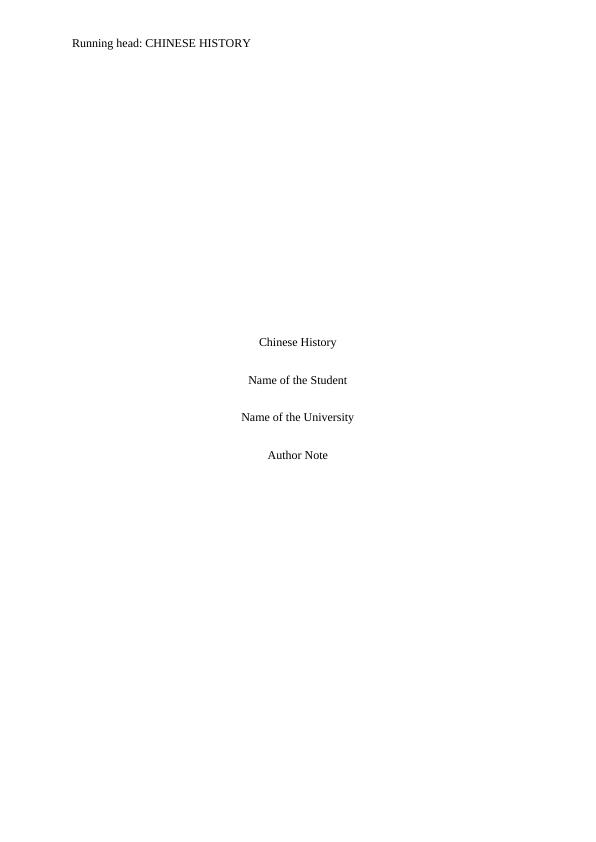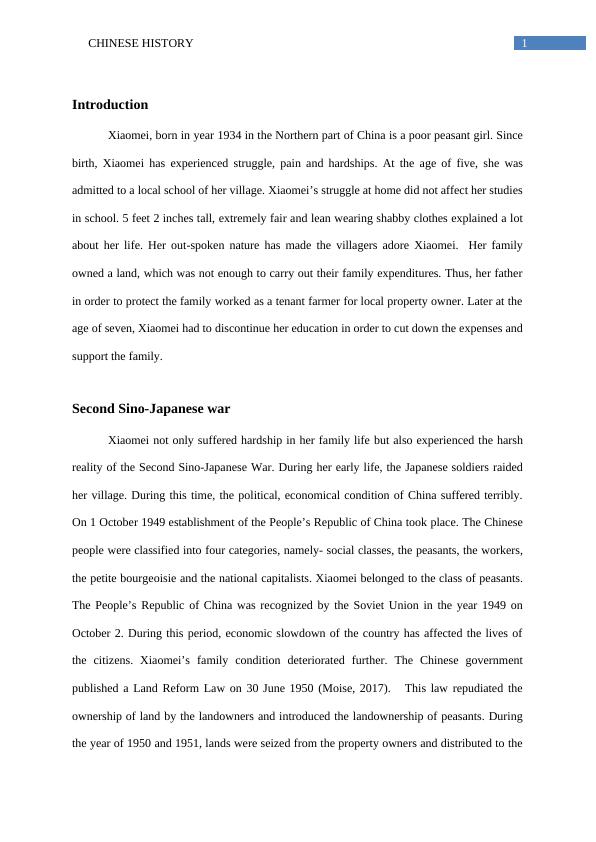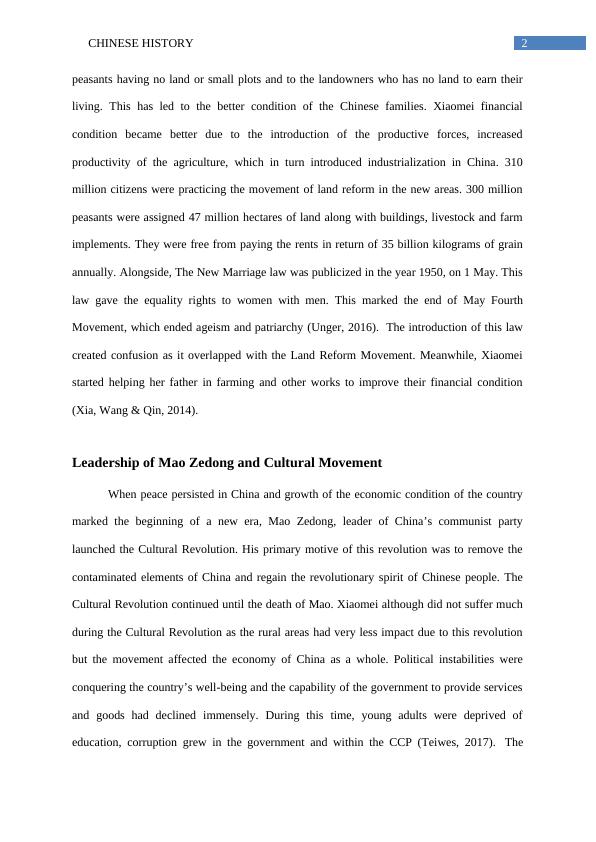Chinese History
Added on 2022-12-22
6 Pages1153 Words87 Views
Running head: CHINESE HISTORY
Chinese History
Name of the Student
Name of the University
Author Note
Chinese History
Name of the Student
Name of the University
Author Note

1CHINESE HISTORY
Introduction
Xiaomei, born in year 1934 in the Northern part of China is a poor peasant girl. Since
birth, Xiaomei has experienced struggle, pain and hardships. At the age of five, she was
admitted to a local school of her village. Xiaomei’s struggle at home did not affect her studies
in school. 5 feet 2 inches tall, extremely fair and lean wearing shabby clothes explained a lot
about her life. Her out-spoken nature has made the villagers adore Xiaomei. Her family
owned a land, which was not enough to carry out their family expenditures. Thus, her father
in order to protect the family worked as a tenant farmer for local property owner. Later at the
age of seven, Xiaomei had to discontinue her education in order to cut down the expenses and
support the family.
Second Sino-Japanese war
Xiaomei not only suffered hardship in her family life but also experienced the harsh
reality of the Second Sino-Japanese War. During her early life, the Japanese soldiers raided
her village. During this time, the political, economical condition of China suffered terribly.
On 1 October 1949 establishment of the People’s Republic of China took place. The Chinese
people were classified into four categories, namely- social classes, the peasants, the workers,
the petite bourgeoisie and the national capitalists. Xiaomei belonged to the class of peasants.
The People’s Republic of China was recognized by the Soviet Union in the year 1949 on
October 2. During this period, economic slowdown of the country has affected the lives of
the citizens. Xiaomei’s family condition deteriorated further. The Chinese government
published a Land Reform Law on 30 June 1950 (Moise, 2017). This law repudiated the
ownership of land by the landowners and introduced the landownership of peasants. During
the year of 1950 and 1951, lands were seized from the property owners and distributed to the
Introduction
Xiaomei, born in year 1934 in the Northern part of China is a poor peasant girl. Since
birth, Xiaomei has experienced struggle, pain and hardships. At the age of five, she was
admitted to a local school of her village. Xiaomei’s struggle at home did not affect her studies
in school. 5 feet 2 inches tall, extremely fair and lean wearing shabby clothes explained a lot
about her life. Her out-spoken nature has made the villagers adore Xiaomei. Her family
owned a land, which was not enough to carry out their family expenditures. Thus, her father
in order to protect the family worked as a tenant farmer for local property owner. Later at the
age of seven, Xiaomei had to discontinue her education in order to cut down the expenses and
support the family.
Second Sino-Japanese war
Xiaomei not only suffered hardship in her family life but also experienced the harsh
reality of the Second Sino-Japanese War. During her early life, the Japanese soldiers raided
her village. During this time, the political, economical condition of China suffered terribly.
On 1 October 1949 establishment of the People’s Republic of China took place. The Chinese
people were classified into four categories, namely- social classes, the peasants, the workers,
the petite bourgeoisie and the national capitalists. Xiaomei belonged to the class of peasants.
The People’s Republic of China was recognized by the Soviet Union in the year 1949 on
October 2. During this period, economic slowdown of the country has affected the lives of
the citizens. Xiaomei’s family condition deteriorated further. The Chinese government
published a Land Reform Law on 30 June 1950 (Moise, 2017). This law repudiated the
ownership of land by the landowners and introduced the landownership of peasants. During
the year of 1950 and 1951, lands were seized from the property owners and distributed to the

2CHINESE HISTORY
peasants having no land or small plots and to the landowners who has no land to earn their
living. This has led to the better condition of the Chinese families. Xiaomei financial
condition became better due to the introduction of the productive forces, increased
productivity of the agriculture, which in turn introduced industrialization in China. 310
million citizens were practicing the movement of land reform in the new areas. 300 million
peasants were assigned 47 million hectares of land along with buildings, livestock and farm
implements. They were free from paying the rents in return of 35 billion kilograms of grain
annually. Alongside, The New Marriage law was publicized in the year 1950, on 1 May. This
law gave the equality rights to women with men. This marked the end of May Fourth
Movement, which ended ageism and patriarchy (Unger, 2016). The introduction of this law
created confusion as it overlapped with the Land Reform Movement. Meanwhile, Xiaomei
started helping her father in farming and other works to improve their financial condition
(Xia, Wang & Qin, 2014).
Leadership of Mao Zedong and Cultural Movement
When peace persisted in China and growth of the economic condition of the country
marked the beginning of a new era, Mao Zedong, leader of China’s communist party
launched the Cultural Revolution. His primary motive of this revolution was to remove the
contaminated elements of China and regain the revolutionary spirit of Chinese people. The
Cultural Revolution continued until the death of Mao. Xiaomei although did not suffer much
during the Cultural Revolution as the rural areas had very less impact due to this revolution
but the movement affected the economy of China as a whole. Political instabilities were
conquering the country’s well-being and the capability of the government to provide services
and goods had declined immensely. During this time, young adults were deprived of
education, corruption grew in the government and within the CCP (Teiwes, 2017). The
peasants having no land or small plots and to the landowners who has no land to earn their
living. This has led to the better condition of the Chinese families. Xiaomei financial
condition became better due to the introduction of the productive forces, increased
productivity of the agriculture, which in turn introduced industrialization in China. 310
million citizens were practicing the movement of land reform in the new areas. 300 million
peasants were assigned 47 million hectares of land along with buildings, livestock and farm
implements. They were free from paying the rents in return of 35 billion kilograms of grain
annually. Alongside, The New Marriage law was publicized in the year 1950, on 1 May. This
law gave the equality rights to women with men. This marked the end of May Fourth
Movement, which ended ageism and patriarchy (Unger, 2016). The introduction of this law
created confusion as it overlapped with the Land Reform Movement. Meanwhile, Xiaomei
started helping her father in farming and other works to improve their financial condition
(Xia, Wang & Qin, 2014).
Leadership of Mao Zedong and Cultural Movement
When peace persisted in China and growth of the economic condition of the country
marked the beginning of a new era, Mao Zedong, leader of China’s communist party
launched the Cultural Revolution. His primary motive of this revolution was to remove the
contaminated elements of China and regain the revolutionary spirit of Chinese people. The
Cultural Revolution continued until the death of Mao. Xiaomei although did not suffer much
during the Cultural Revolution as the rural areas had very less impact due to this revolution
but the movement affected the economy of China as a whole. Political instabilities were
conquering the country’s well-being and the capability of the government to provide services
and goods had declined immensely. During this time, young adults were deprived of
education, corruption grew in the government and within the CCP (Teiwes, 2017). The

End of preview
Want to access all the pages? Upload your documents or become a member.
